Host: Fraser Cain (@fcain)
Astrojournalist: Morgan Rehnberg (cosmicchatter.org / @cosmic_chatter)
This Week’s Stories:
Continue reading “Weekly Space Hangout – February 21, 2014: Two-Man Show!”
Host: Fraser Cain (@fcain)
Astrojournalist: Morgan Rehnberg (cosmicchatter.org / @cosmic_chatter)
This Week’s Stories:
Continue reading “Weekly Space Hangout – February 21, 2014: Two-Man Show!”
Become a Patron of Universe Today
Since we started Universe Today almost 15 years ago, we’ve been entirely supported by advertising (and my savings). But now there’s an exciting new service called Patreon which allows fans to directly support the projects they love.
And if you’re a regular reader of Universe Today, you know we’ve got tens of thousands of articles, and a steady stream of podcasts, videos, graphics and interactive applications. We’ve got a pretty big team of writers and this stuff is expensive.
If you’re a serious fan of Universe Today, consider joining our Patreon community. You’ll get:
NASA’s Galileo spacecraft arrived at Jupiter on December 7, 1995, and proceeded to study the giant planet for almost 8 years. It sent back a tremendous amount of scientific information that revolutionized our understanding of the Jovian system. By the end of its mission, Galileo was worn down. Instruments were failing and scientists were worried they wouldn’t be able to communicate with the spacecraft in the future. If they lost contact, Galileo would continue to orbit the Jupiter and potentially crash into one of its icy moons.
Galileo would certainly have Earth bacteria on board, which might contaminate the pristine environments of the Jovian moons, and so NASA decided it would be best to crash Galileo into Jupiter, removing the risk entirely. Although everyone in the scientific community were certain this was the safe and wise thing to do, there were a small group of people concerned that crashing Galileo into Jupiter, with its Plutonium thermal reactor, might cause a cascade reaction that would ignite Jupiter into a second star in the Solar System.
Hydrogen bombs are ignited by detonating plutonium, and Jupiter’s got a lot of hydrogen.Since we don’t have a second star, you’ll be glad to know this didn’t happen. Could it have happened? Could it ever happen? The answer, of course, is a series of nos. No, it couldn’t have happened. There’s no way it could ever happen… or is there?
Jupiter is mostly made of hydrogen, in order to turn it into a giant fireball you’d need oxygen to burn it. Water tells us what the recipe is. There are two atoms of hydrogen to one atom of oxygen. If you can get the two elements together in those quantities, you get water.
In other words, if you could surround Jupiter with half again more Jupiter’s worth of oxygen, you’d get a Jupiter plus a half sized fireball. It would turn into water and release energy. But that much oxygen isn’t handy, and even though it’s a giant ball of fire, that’s still not a star anyway. In fact, stars aren’t “burning” at all, at least, not in the combustion sense.
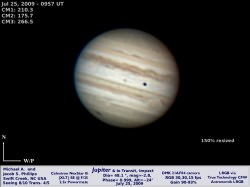
Our Sun produces its energy through fusion. The vast gravity compresses hydrogen down to the point that high pressure and temperatures cram hydrogen atoms into helium. This is a fusion reaction. It generates excess energy, and so the Sun is bright. And the only way you can get a reaction like this is when you bring together a massive amount of hydrogen. In fact… you’d need a star’s worth of hydrogen. Jupiter is a thousand times less massive than the Sun. One thousand times less massive. In other words, if you crashed 1000 Jupiters together, then we’d have a second actual Sun in our Solar System.
But the Sun isn’t the smallest possible star you can have. In fact, if you have about 7.5% the mass of the Sun’s worth of hydrogen collected together, you’ll get a red dwarf star. So the smallest red dwarf star is still about 80 times the mass of Jupiter. You know the drill, find 79 more Jupiters, crash them into Jupiter, and we’d have a second star in the Solar System.
There’s another object that’s less massive than a red dwarf, but it’s still sort of star like: a brown dwarf. This is an object which isn’t massive enough to ignite in true fusion, but it’s still massive enough that deuterium, a variant of hydrogen, will fuse. You can get a brown dwarf with only 13 times the mass of Jupiter. Now that’s not so hard, right? Find 13 more Jupiters, crash them into the planet?
As was demonstrated with Galileo, igniting Jupiter or its hydrogen is not a simple matter.
We won’t get a second star unless there’s a series of catastrophic collisions in the Solar System.
And if that happens… we’ll have other problems on our hands.
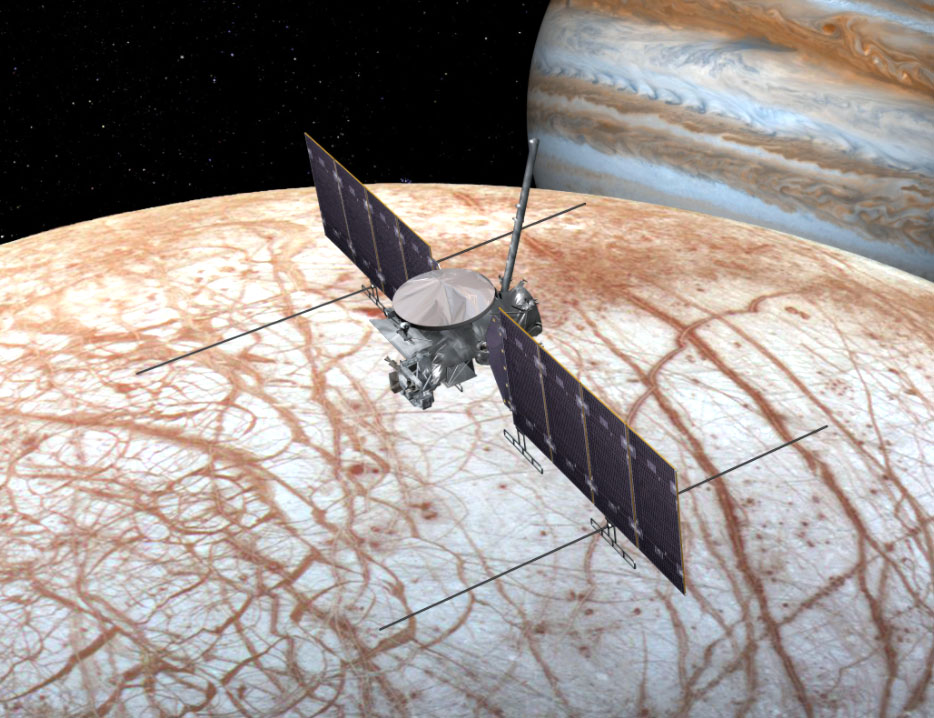
Forget Mars, the place we really want to go looking for life is Jupiter’s moon Europa. Dr. Mike Brown, a professor of planetary science at Caltech, explains what he finds so fascinating about this icy moon, and the potential we might find life swimming in its vast oceans.
Continue reading “Why Europa?”
Pop quiz. How did Einstein win his Nobel prize? Was it for relativity? Nope, Einstein won the Nobel Prize in 1921 for the discovery of the photoelectric effect; how electrons are emitted from atoms when they absorb photons of light. But what is it? Let’s find out.
Continue reading “Astronomy Cast Ep. 335: Photoelectric Effect”
You’ve probably heard the saying “everything’s relative”. When you consider our place in the Universe, everything really is relative. I’m recording this halfway up Vancouver Island, in the Pacific Ocean, off the West Coast of Canada. And where I’m standing is about 6,370 kilometers away from the center of the Earth, that way.
From my perspective, the Sun is over there. It’s as large as a dime held at arm’s length. For me it’s really, really far away. In fact, at this exact time it’s further away than any object I you can see with the naked eye.I’m about 150 million kilometers away from the Sun, and so are you.
We’re carving out an elliptical orbit which takes one full year to complete one whole trip around. You, me and the Earth are all located inside our Solar System. Which contains the Sun, 8 planets and a vast collection of ice, rocks and dust. We’re embedded deep within our galaxy, the Milky Way. It’s a big flat disk of stars measuring up to 120,000 light years across.
Our Solar System is located in the middle of this galactic disk. And by the middle, I mean the center of the galaxy is about 27,000 light years that way, and the edge of the galaxy is about the same distance that way.
Our Milky Way is but one galaxy in a larger collection of galaxies known as the Local Group. There are 36 known objects in the local group. Which are mostly dwarf galaxies. However, there’s also the Triangulum Galaxy, the Milky Way, and the Andromeda galaxy… which is by far the largest, most massive object in the Local Group, It’s twice the size and 4 times the mass of the Milky Way.
But where is it?
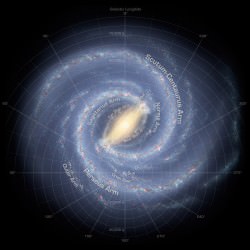
From me, and you, Andromeda is located just an astronomically distant 2.5 million light years that way. Or would that be just short 2.5 million light-years that away? I’m sure you see where this is going.
The Local Group is embedded within a much larger group known as the Virgo Supercluster, containing at least 100 galaxy groups and clusters. The rough center of the supercluster is in the constellation Virgo. Which as of right now, is that way, about 65 million light years away. Which certainly makes the 2.5 million light years to Andromeda seem like an afternoon jaunt in the family car.
Unsurprisingly, The Virgo Supercluster is a part of a larger structure as well. The Pisces-Cetus Supercluster Complex. This is a vast filament of galactic superclusters measuring about 150 million light years across AND a billion light years long. The middle is just over that way. Right over there.
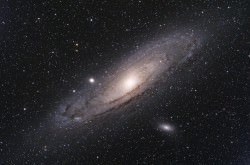
One billion light years in length? Well that makes Andromeda seem right around the corner. So where are we? Where are you, and I and the Earth located in the entire Universe? The edge of the observable Universe is about 13.8 billion light years that way. But it’s also 13.8 billion light years that way. And that way, and that way.
And cosmologists think that if you travel in any direction long enough, you’ll return to your starting point, just like how you can travel in any one direction on the surface of the Earth and return right back at your starting point. In other words, the Earth is located at the very, very center of the Universe. Which sounds truly amazing.
What a strange coincidence for you and I to be located right here. Dead center. Smack dab right in the middle of the Universe. Certainly makes us sound important doesn’t it? But considering that every other spot in the Universe is also located at the center of the universe.
You heard me right. Every single spot that you can imagine inside the Universe is also the center of the Universe. That definitely complicates things in our plans for Universal relevance. And all this sure does make Andromeda seem close by….and it’s still just right over there, at the center of the Universe. Oh, and about every spot in the universe being the center of the Universe? Well, we’ll save that one for another episode.
Hosts: Fraser Cain & Scott Lewis
Astronomers: David Dickinson, Gary Gonella, James McGee, Tom Nathe, Mike Phillips, Mike Simmons, Roy Salisbury, Shahrin Ahmad
Views tonight: Horsehead Nebula, Flame Nebula, Europa Transit of Jupiter with Great Red Spot, a cluster of sunspots, Rosette Nebula, a near-Earth asteroid, a capture of Barnard’s Loop, Orion Nebula, M81, various telescopes of the astronomers, our moon, another transit of Jupiter by one of the moons, M67, NGC 2169-the “37” Cluster, our moon – full view, California Nebula.
We hold the Virtual Star Party every Sunday night as a live Google+ Hangout on Air. We begin the show when it gets dark on the West Coast. If you want to get a notification, make sure you circle the Virtual Star Party on Google+. You can watch on our YouTube channel or here on Universe Today.
Host: Nicole Gugliucci
Astrojournalists: Morgan Rehnberg, Brian Koberlein
Continue reading “Weekly Space Hangout – February 14, 2014: Space Valentines!”
There is nothing in the Universe more awe inspiring or mysterious than a black hole. Because of their massive gravity and ability to absorb even light, they defy our attempts to understand them. All their secrets hide behind the veil of the event horizon.
What do they look like? We don’t know. They absorb all the radiation they emit. How big are they? Do they have a size, or could they be infinitely dense? We just don’t know. But there are a few things we can know. Like how massive they are, and how fast they’re spinning.
Wait, what? Spinning?
Consider the massive star that came before the black hole. It was formed from a solar nebula, gaining its rotation by averaging out the momentum of all the individual particles in the cloud. As mutual gravity pulled the star together, through the conservation of angular momentum it rotated more rapidly. When a star becomes a black hole, it still has all that mass, but now compressed down into an infinitesimally smaller space. And to conserve that angular momentum, the black hole’s rate of rotation speeds up… a lot.The entire history of everything the black hole ever consumed, averaged down to a single number: the spin rate.
If the black hole could shrink down to an infinitely small size, you would think that the spin rate might increase to infinity too. But black holes have a speed limit.
“There is a speed limit to the spin of a black hole. It’s sort of set by the faster a black hole spins, the smaller is its event horizon.”
That’s Dr. Mark Morris, a professor of astronomy at UCLA. He has devoted much of his time to researching the mysteries of black holes.
“There is this region, called the ergosphere between the event horizon and another boundary, outside. The ergosphere is a very interesting region outside the event horizon in which a variety of interesting effects can occur.”
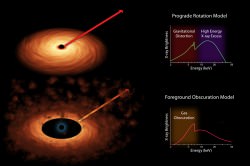
Imagine the event horizon of a black hole as a sphere in space, and then surrounding this black hole is the ergosphere. The faster the black hole spins, the more this ergosphere flattens out.
“The speed limit is set by the event horizon, eventually, at a high enough spin, reaches the singularity. You can’t have what’s called a naked singularity. You can’t have a singularity exposed to the rest of the Universe. That would mean that the singularity itself could emit energy or light and somebody outside could actually see it. And that can’t happen. That’s the physical limitation of how fast it can spin. Physicists use units for angular momentum that are cast in terms of mass, which is a curious thing, and the speed limit can be described as the angular momentum equals the mass of the black hole, and that sets the speed limit.”
Just imagine. The black hole spins up to the point that it’s just about to reveal itself. But that’s impossible. The laws of physics won’t let it spin any faster. And here’s the amazing part. Astronomers have actually detected supermassive black holes spinning at the limits predicted by these theories.
One black hole, at the heart of galaxy NGC 1365 is turning at 84% the speed of light. It has reached the cosmic speed limit, and can’t spin any faster without revealing its singularity.
The Universe is a crazy place.
When astronomers first discovered other planets, they were completely unlike anything we’ve ever found in the Solar System. These first planets were known as “hot jupiters”, because they’re giant planets – even more massive than Jupiter – but they orbit closer to their star than Mercury. Dr. Heather Knutson, a professor at Caltech explains these amazing objects.
“My name is Heather Knutson, and I’m a professor in the planetary science department here at Caltech. I study the properties of extrasolar planets, which are planets that orbit stars other than the sun, so mostly these are our closest exoplanetary neighbors. We’re not talking about planets in other galaxies – we’re mostly talking about planets which are in the same part of our own corner of our galaxy. So these are around some of the closest stars to the sun.”
What is a hot jupiter?
“The planets that I’ve found the most surprising, out of all of the ones I’ve discovered so far, I guess the sort of classic example, is that we’ve see these sorts of giant planets which are very similar to Jupiter, but orbit very much closer in than Mercury is to our sun, so these planets orbit their sun every two or three days and are absolutely getting roasted. We know that they couldn’t have formed there – they had to have formed farther out and migrated in, so what we’re still trying to understand are what are the forces that caused them to migrate in, whereas Jupiter seems to have migrated a little bit but more or less stayed put in our own solar system.”
What do hot jupiters mean for our understanding our own Solar System?
“The implications of these “hot jupiters” as we call them are actually huge for our own solar system, because if you want to know how many potentially habitable earthlike planets are out there, having one of these giant planets just rampage their way though the inner part of the planetary system, and it could toss out your habitable earth and put it into either a much closer orbit or a much further orbit. So knowing how things have moved around will tell you a lot about where you might find interesting planets.”
What is their atmosphere like?
“So, the atmospheres of hot jupiters are very exotic, by solar system standards. They typically have temperatures of a thousand to several thousand Kelvin, so at these temperatures these planets could have clouds of molten rock, for example. They have atmospheric compositions that would seem very exotic to us – they’re actually more similar to the compositions of relatively cool stars, so we have to adapt to describe these planets – we actually use stellar models to describe their atmospheres. We think that they’re also probably also tidally locked, which is very interesting because it means that one side of the planet is getting all of the heat and the other side is sort of in permanent night. And one thing we do is to try and understand the effect that has on the weather patterns on these planets, so you have winds that are pretty good at carrying that around the night side and mixing everything up, or do these planets have these just extreme temperature gradients between the day side and the night side.”
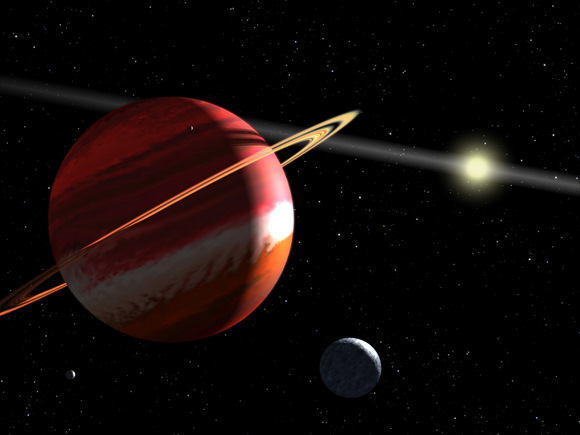
How’d they get there?
“So, we have a couple of theories for how hot jupiters may have ended up in their present day orbits. One theory is, that after they formed, that they were still embedded in the gas disc where they formed, and maybe they interacted with the disc as such that it kind of torqued and pulled them and so that’s kind of an early migration theory. There’s also a late migration theory version where when after the disc had gone away, these planets had interacted with a third body in the system, so maybe you had another distant massive planet or maybe you had a planet that was part of a binary star system, and those three body interactions excited a large orbital eccentricity in the innermost planet, and once it starts coming in closer to the star, the tides start to damp out the eccentricities, so what you end up with is something which is a gas giant planet in a very short period circular orbit.
So that’s kind of a more complicated story, but there are some clues in the data that might be true for at least a subset of the hot jupiters that we study.”